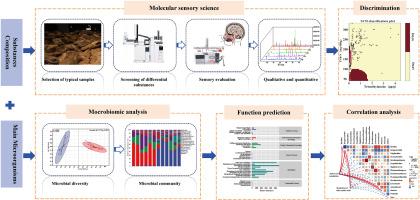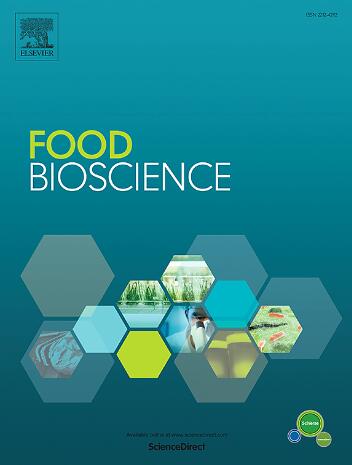Analysis and formation mechanism of Key aroma compounds with ammonia-like off-flavors in Jiang-flavored high-temperature daqu: Substances composition and main microorganisms
IF 5.9
1区 农林科学
Q1 FOOD SCIENCE & TECHNOLOGY
引用次数: 0
Abstract
Ammonia odor is a notable off-flavor in Jiang-flavored high-temperature Daqu, impacting its quality, but the substances composition and formation of this odor are still unknown. In this study, molecular sensory science was employed to identify the key flavor compounds responsible for the ammonia odor in Daqu, while microbiomic analysis, correlation analysis, and functional gene prediction were conducted to investigate the mechanisms of their formation. Trimethylamine was identified as the predominant component contributing to the ammonia odor characteristic of Daqu. Subsequent microbial community analysis revealed that Bacillus, Kroppenstedtia, Thermoascus, and Thermomyces were the dominant microorganisms differentiating ammonia-flavored Daqu (AFDQ) from non-ammonia-flavored Daqu (NFDQ). Moreover, significant variations in the amino acid metabolic pathways of the bacterial community functional genes between these two Daqu types further influenced the development of the ammonia flavor. Concurrently, the research findings were applied to the Daqu production process for the identification of AFDQ. A support vector machine (SVM) discrimination model was developed based on trimethylamine and total volatile basic nitrogen levels, demonstrating robust performance in distinguishing AFDQ from NFDQ. These findings provide new insights into the flavor formation mechanisms of ammonia-flavored Daqu and offer a scientific basis for its quality control and optimization.

江味高温大曲中含氨类异味的关键香气化合物及其形成机理分析:物质组成及主要微生物
氨臭是江味高温大曲中显著的异味,影响其品质,但氨臭的物质组成及形成尚不清楚。本研究采用分子感官科学方法鉴定大曲氨臭的关键风味化合物,并通过微生物组学分析、相关分析和功能基因预测等方法探讨其形成机制。三甲胺是造成大曲氨臭的主要成分。微生物群落分析表明,芽孢杆菌、Kroppenstedtia、Thermoascus和Thermomyces是区分氨味大曲(AFDQ)和非氨味大曲(NFDQ)的优势微生物。此外,这两种大曲类型细菌群落功能基因氨基酸代谢途径的显著差异进一步影响了氨味的发育。同时,将研究结果应用于大曲生产工艺中,对AFDQ进行鉴定。建立了基于三甲胺和总挥发性碱性氮水平的支持向量机(SVM)判别模型,在判别AFDQ和NFDQ方面表现出稳健的性能。这些发现为揭示氨味大曲风味形成机理提供了新的思路,并为其质量控制和优化提供了科学依据。
本文章由计算机程序翻译,如有差异,请以英文原文为准。
求助全文
约1分钟内获得全文
求助全文
来源期刊

Food Bioscience
Biochemistry, Genetics and Molecular Biology-Biochemistry
CiteScore
6.40
自引率
5.80%
发文量
671
审稿时长
27 days
期刊介绍:
Food Bioscience is a peer-reviewed journal that aims to provide a forum for recent developments in the field of bio-related food research. The journal focuses on both fundamental and applied research worldwide, with special attention to ethnic and cultural aspects of food bioresearch.
 求助内容:
求助内容: 应助结果提醒方式:
应助结果提醒方式:


